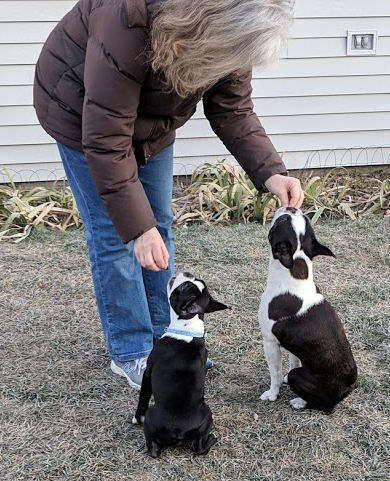Dog training is a bargain you make with your dog. They get what they want when we get what we want. Food is dog training currency.
There’s a brilliant example of this in Ore Ida’s current advertising campaign. It’s “Potato Pay.” Fundamentally, it’s bribing your kids with french fries to eat their vegetables. If you haven’t checked out the website, it’s great for a few chuckles. We particularly enjoyed the “Frynancial Guide.” We realize it’s only half serious, and so does Ore-Ida: “Is it ethical? No. But it is edible, and a win-win for both fussy eaters and parents.”
But wait! We don’t bribe our dogs!

Of course we do! The difference is that our dogs don’t really understand the “deal” the way people do. That’s why it’s so crucial to establish the relationship between action and reward. The clicker builds in a little delay “that was good, keep going, the reward is coming.” But the reward must always follow the action. Dogs are always rewarded for choosing well. Every single time.
People talk about “fading” out the reward or not using food for training their dogs. How do they motivate their dogs to work for them? And are they, or their dogs, having any fun with training?
In human terms: You have a job you love. You love everything about it – the work, the place, the people. Would you still do that job if you didn’t get paid? Would a hearty “Atta Girl!” really be enough compensation?
It really is just that simple.
Don’t be stingy with dog training currency
People often say they don’t want their dogs to get fat. It’s a legitimate concern. Dog obesity has been on the rise and is a significant factor in dog health. That doesn’t mean you skimp on training rewards. Instead, how about setting aside a portion of your dog’s food to use for training treats? His/her meal may be smaller, but if your dog inhales his/her food in seconds, will he/she notice?
You can even feed your dog 100 percent from your hand. Why not make meal time training time? It would certainly be more fun for both of you. You have to feed your dog anyway. Think about making it a 2-Minute Training session. You can certainly play “Touch!” for a couple minutes in the kitchen. Whatever’s left in the dog bowl, that can be your dog’s meal, if anything. We’ve talked about this before, and offered other strategies for keeping the calorie count down.
Pay your dog
Pre-pandemic, all human cultures shared one particular ritual – bonding over food. It works for all people through time, from the legend of the first Thanksgiving to the “business lunch.” We may not be able to sit at a table with our dogs and share a banquet, but we can certainly bond over food.
Food motivates our dogs to try to understand what we’re saying. The hardest case we’ve known was our own Tango. He adored Fran from the moment he saw her. He hated everyone else – including Hope. It wasn’t simple avoidance and warning, Tango actively tried to bite.
Hope spent weeks hand-feeding Tango for every dinner. At first she just handed him the food, one piece at a time while she babbled nonsense to him. Then she started asking for simple behaviors; “sit,” “down,” “stand.” It wasn’t fast, but it worked. Tango has become a model citizen and host. Anyone is welcome in his home.
Payment in kind
If, by chance, you don’t have a food-motivated dog or your dog has food sensitivities, your path is a little more difficult, but not impossible. Find the currency that’s most valuable to your dog. It could be tug toys, or a ball. Try different foods and see if his/her taste buds can be tempted. Cheese? Popcorn? Dried shrimp? Can you soak prescription food in some meat broth and then let it dry again? Or dust it with grated parmesan?
Some dogs even find the training games themselves enough of a reward. If that’s the case, your dog is a gem. Play with your dog!
